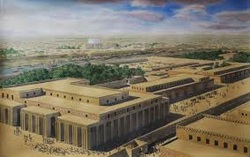City

- The world's first cities appeared in Mesopotamia and these cities were Babylon and Eridu.
- Babylon became important when Hammurabi made it his capital of his kingdom of Babylonia.
- Babylonia was destroyed in 698 B.C by Assyrians under Sennacherib.
- Many cities were used as burial grounds where many families buried belongings and corpses under there homes.
Organized Government

- The rulers were inscribed in stone.
- Mesopotamia was ruled by Hammurabi.
- The weak and powerless were protected.
- The Laws of Hammurabi are the longest and best-organized collections of law
- Ruled by kings- had absolute power
City

- The world's first cities appeared in Mesopotamia and these cities were Babylon and Eridu.
- Babylon became important when Hammurabi made it his capital of his kingdom of Babylonia.
- Babylonia was destroyed in 698 B.C by Assyrians under Sennacherib.
- Many cities were used as burial grounds where many families buried belongings and corpses under there homes.
Organized Government

- The rulers were inscribed in stone.
- Mesopotamia was ruled by Hammurabi.
- The weak and powerless were protected.
- The Laws of Hammurabi are the longest and best-organized collections of law
- Ruled by kings- had absolute power
Complex Religion

- Had a polytheistic belief system
- Worshipped many gods and goddesses- influenced much of what happened to them in their lives
- Meaning of life was to live life contently
- Religion helped them face dangers and their fears
Job Specialization

- Some of the jobs in ancient Mesopotamia included farming, pottery, weaving, teachers, astronomers, and livestock raising
- Trading was also a big deal in Mesopotamia
Complex Religion

- Had a polytheistic belief system
- Worshipped many gods and goddesses- influenced much of what happened to them in their lives
- Meaning of life was to live life contently
- Religion helped them face dangers and their fears
Job Specialization

- Some of the jobs in ancient Mesopotamia included farming, pottery, weaving, teachers, astronomers, and livestock raising
- Trading was also a big deal in Mesopotamia
Social Classes

There are 6 different social classes in the Ancient Mesopotamia Hierarchy: Kings, Priest, Scribes, Merchants and Artisans, Commoners, and Slaves.
King: Was the top rank holder of the social class Ancient Mesopotamia; the king created the laws for the civilization; served as the head of the army
Priest: the upper class; considered as the doctors of that time; very influential because religion was important during that time
Scribes: the upper class; well educated; undergo a training program to be a scribe
Merchants and Artisans: the upper class; had a major role in creating wealth and growth of the civilization
Commoners: laboring lower class; engaged in agriculture; not educated
The Slaves: were at the bottom of the social class; had no rights and worked for the upper class
Social Classes

There are 6 different social classes in the Ancient Mesopotamia Hierarchy: Kings, Priest, Scribes, Merchants and Artisans, Commoners, and Slaves.
King: Was the top rank holder of the social class Ancient Mesopotamia; the king created the laws for the civilization; served as the head of the army
Priest: the upper class; considered as the doctors of that time; very influential because religion was important during that time
Scribes: the upper class; well educated; undergo a training program to be a scribe
Merchants and Artisans: the upper class; had a major role in creating wealth and growth of the civilization
Commoners: laboring lower class; engaged in agriculture; not educated
The Slaves: were at the bottom of the social class; had no rights and worked for the upper class
Public Work

- The king had made irrigation works to boost the economy.
- Some types of public work are making irrigation systems, building ziggurats, creating sewage systems, making moats, and building public bathrooms.
- Writing

The earliest writing was based on pictographs, that were used to communicate basic information.
Over time, the need for writing changed and cuneiform was developed.
Cuneiform was the official Mesopotamia writing form.
Mesopotamia scribes recorded daily events, trade. astronomy, and literature on clay tablets.
They kept excellent records and list of things.
Public Work

- The king had made irrigation works to boost the economy.
- Some types of public work are making irrigation systems, building ziggurats, creating sewage systems, making moats, and building public bathrooms.
Writing

The earliest writing was based on pictographs, that were used to communicate basic information.
Over time, the need for writing changed and cuneiform was developed.
Cuneiform was the official Mesopotamia writing form.
Mesopotamia scribes recorded daily events, trade. astronomy, and literature on clay tablets.
They kept excellent records and a list of things.
1 trait is...
city
4 trait is...
job specialization
6 what trait
Arts and Architecture
8 trait is...
Writing